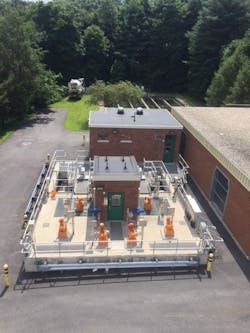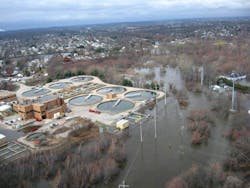Plant Profile: Smithfield Wastewater Treatment Facility & Cranston Wastewater Treatment Facility
About the author:
Cristina Tuser is associate editor for WWD. Tuser can be reached at [email protected].
The Smithfield Wastewater Treatment Facility (WWTF) processes an average of 2 million gallons of water per day (mgd), serving approximately 20,000 customers in the town of Smithfield, Rhode Island. Smithfield WWTF can treat a maximum capacity of approximately 3.5 mgd.
The facility was awarded the Gold Award for Permit Compliance in 2018 and 2019, and it discharges water into the Woonasquatucket River and ultimately, the Narragansett Bay.
The plant, operated for the town of Smithfield by Veolia Water, has 12 pumping stations that bring all of the water to the wastewater facility, before passing through primary screenings with no grit removal. From primary treatment up to activated sludge, the facility uses an anaerobic/anoxic/oxic (A2O) process, along with nitrification and denitrification before reaching the secondary clarifiers.
The WWTF uses the Actiflo Process, which combines conventional coagulation and flocculation processes for phosphorus and zinc removal. From there, disinfection and dechlorination take place.
“This crew has committed to the facility, and really to the community, in making sure that there’s clean water,” said Kevin Regan, project manager for Veolia Water. “This is an essential job that we do, and this type of award makes me proud. I’m honored that I can work with this team here.”
A goal for the facility is to maintain compliance regardless of the weather conditions.
Storms in March 2010 caused multiple operational failures with the collection and treatment systems, including flooding of the WWTF access road and flooding of the disinfection system, but these matters were ultimately addressed. There were also significant capacity shortfalls with the Roger Williams Drive Pumping Station and the Farnum Pike Pumping Station, both requiring mitigation with vacuum trucks.
The WWTF is currently working with the town on a capital improvement program, which aims to install an aerated grit removal system in 2021 or 2022. This system would protect the facility from sand and other inorganic material brought in by heavy rainfall. Additionally, consideration is being made for upgrades to the programmable logic controller system in the facility.
In 2020, the Smithfield WWTF, alongside the Cranston WWTF, were recognized with the 2020 Platinum Award, which is handed out annually by the Rhode Island Clean Water Association for maintaining a perfect record of compliance with its operating permit for three consecutive years or more.
Cranston & The Flood of 2010
Cranston WWTF processes 24 mgd, discharging treated water into the Pawtuxet River, which dumps out into Narragansett Bay. The original facility was built in 1942 but the current facility was constructed in 1982, with its most recent upgrade in 2016. It treats a daily average of 13 mgd. The treatment facility and collection system are operated for the city of Cranston by Veolia Water.
Earl Salisbury, superintendent of the Cranston facility, said the plant is an advanced wastewater treatment facility. The water comes into the headworks and undergoes preliminary treatment before fine screens take out all of the debris. This is followed by grit removal, primary treatment, and secondary treatment, during which nutrients, such as phosphorus and ammonia are removed.
A recent upgrade in 2014 involved the Actiflo Process. This process is efficient in treating algal blooms and phosphorus removal, Salisbury said.
“One of the biggest focuses is the nutrient removal with the phosphorus and ammonia,” Salisbury said. “The other thing about this particular facility is that we are also a merchant biosolids disposal facility.”
There are two incinerators on site, and the facility takes in sludge from a few sites in Maine and New Hampshire.
“We’re taking in about 40 dry tons of sludge a day and incinerating it,” Salisbury added.
In the historic Flood of 2010, Cranston’s facility flooded, as well as three pump stations in the city, cutting off connections to hundreds of homes. Upon flooding, the incoming flow for the facility had reached 40 mgd, about three times the normal flow.
Operators who checked pump stations discovered that the Pontiac Avenue pump station, which handles roughly 70% of total flow to the treatment plant, was beginning to flood with waters from the nearby Pocasset River, a tributary of the Pawtuxet.
The facility had reached the upper limit of what it could handle, so additional clarifiers and pumps were brought online to take some of the extra flow. Once the facility lost power to the dechlorination building, the lower end of the plant flooded, so the WWTF took its sludge incinerator offline. When the dust settled, the team had lost the Pontiac Avenue pump station and two smaller stations.
In 2018, Cranston WWTF went through an upgrade that changed the facility’s biological nutrient removal process technology from a standard MLE process to a Bardenpho process. Combined with a flocculation process, this allowed for better efficiency for phosphorus removal.
Nevertheless, the facility of 42 employees has persisted in its efforts to maintain the facility and its operations.


